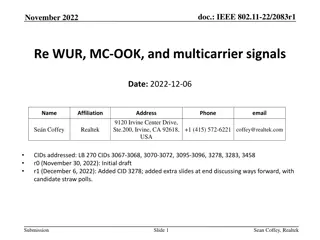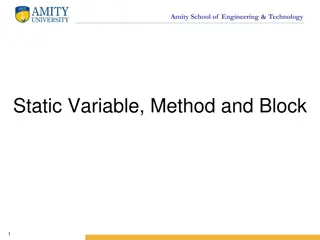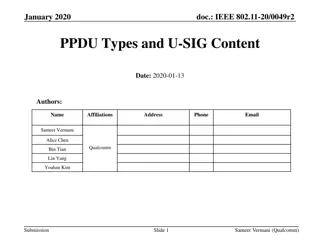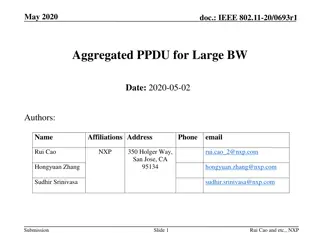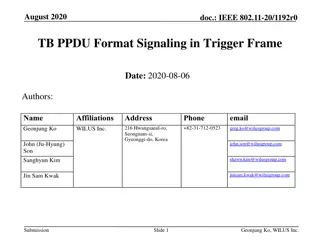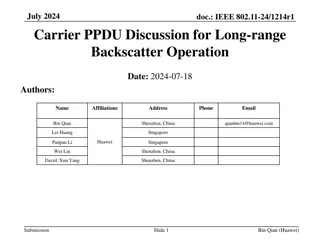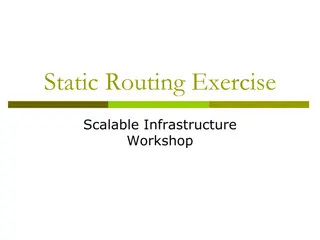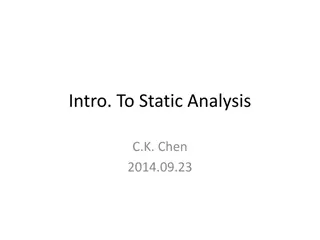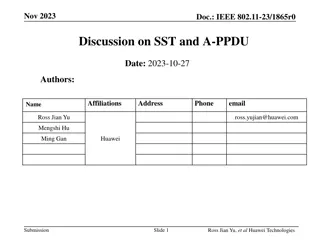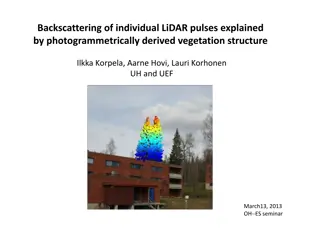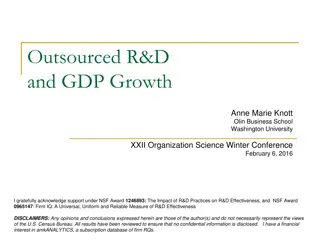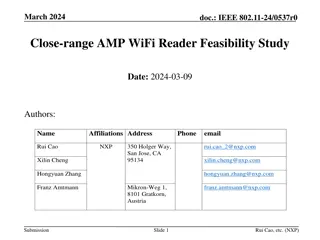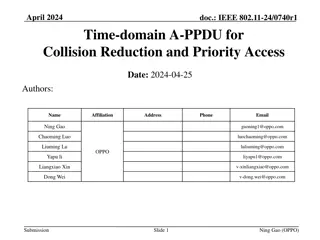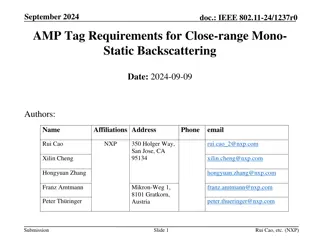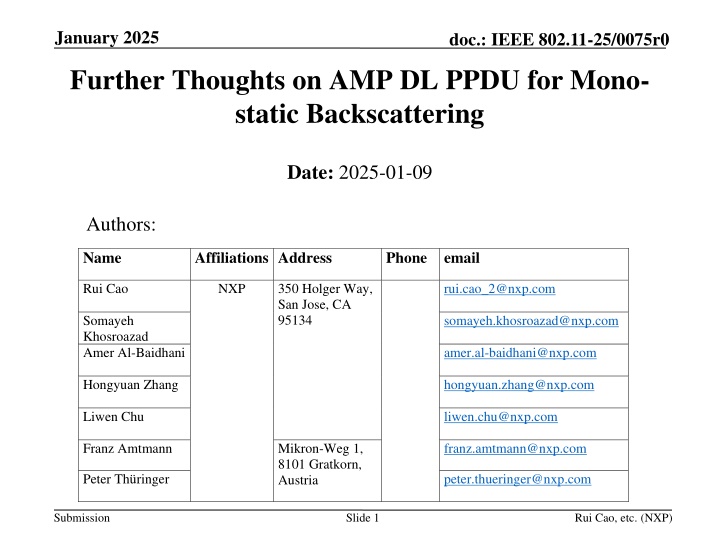
IEEE 802.11-25/0075r0 Further Thoughts on AMP DL PPDU
In the January 2025 document, the authors from NXP present discussions on DL PPDU design for backscattering, including benefits of separate definitions and AMP tag capabilities. They delve into unifying SYNC design and addressing operational aspects for better medium utilization. The document explores AMP tag operations, inventory procedures, and examples to enhance understanding of DL PPDU considerations for effective implementation.
Download Presentation

Please find below an Image/Link to download the presentation.
The content on the website is provided AS IS for your information and personal use only. It may not be sold, licensed, or shared on other websites without obtaining consent from the author. If you encounter any issues during the download, it is possible that the publisher has removed the file from their server.
You are allowed to download the files provided on this website for personal or commercial use, subject to the condition that they are used lawfully. All files are the property of their respective owners.
The content on the website is provided AS IS for your information and personal use only. It may not be sold, licensed, or shared on other websites without obtaining consent from the author.
E N D
Presentation Transcript
January 2025 doc.: IEEE 802.11-25/0075r0 Further Thoughts on AMP DL PPDU for Mono- static Backscattering Date: 2025-01-09 Authors: Name Affiliations Address Phone email NXP Rui Cao 350 Holger Way, San Jose, CA 95134 rui.cao_2@nxp.com Somayeh Khosroazad Amer Al-Baidhani somayeh.khosroazad@nxp.com amer.al-baidhani@nxp.com Hongyuan Zhang hongyuan.zhang@nxp.com Liwen Chu liwen.chu@nxp.com Franz Amtmann Mikron-Weg 1, 8101 Gratkorn, Austria franz.amtmann@nxp.com Peter Th ringer peter.thueringer@nxp.com Submission Slide 1 Rui Cao, etc. (NXP)
January 2025 doc.: IEEE 802.11-25/0075r0 Introduction The group is trying to unify the DL PPDU design support multiple use cases and hardware capabilities agreed on one PPDU format [1], we proposed unified SYNC design The group agreed on SYNC chip duration of 2us for backscattering In this contribution, some further thoughts on DL PPDU design Potential benefits of separate DL PPDU definition Backscattering PPDU design Submission Slide 2 Rui Cao, etc. (NXP)
January 2025 doc.: IEEE 802.11-25/0075r0 AMP Tag DL Rx Capability Backscattering Tags Wakeup Tags/function DL (2.4 GHz) Active Tags WideBW (~80MHz) WideBW (~80MHz) NarrowBW (~4MHz) Rx RF/analogue Operating RSSI up to -20dBm up to -70dBm up to -70dBm ~2MHz 100kppm ~8MHz 1000ppm ~8MHz 1000ppm Operating clock 2.4GHz Excitation Yes No No Submission Slide 3 Rui Cao, etc. (NXP)
January 2025 doc.: IEEE 802.11-25/0075r0 Unassociated AMP Tag operation AMP backscattering tags are in unassociated operation AMP reader needs to discover ( inventory ) the available tags within coverage This process is based on random access in nature The number of tags is unknown, counting pupils in the dark room The inventory time is dynamic AMP reader needs some flexibility to control TXOP Achieve better medium utilization Submission Slide 4 Rui Cao, etc. (NXP)
January 2025 doc.: IEEE 802.11-25/0075r0 Inventory Operation Examples TXOP Successful Read CTS CF-end Query Ack Excitation Excitation RN16 EPC Tag 1 Successful Read CTS Query Query rep Query rep Ack Query rep Ack Excitation Excitation Excitation Excitation Excitation Excitation No reply Invalid ACK No reply RN16 EPC Tag 1 RN16 RN16 Tag 2 RN16 The inventory round duration can vary by many factors: Number of tags, error recovery, etc. PHY preamble LENTH cannot be revised after transmission MAC has more flexibility to end TXOP using CF-end frame Better channel utilization efficiency Submission Slide 5 Rui Cao, etc. (NXP)
January 2025 doc.: IEEE 802.11-25/0075r0 Revisit DL PPDU Design [3] asks the question whether to have separate SYNC? AMP DL PPDU WideBW 802.11 preamble + Narrowband single carrier LENGTH field indicates the entire PPDU duration WiFi preamble SYNC-Data Excitation Excitation Excitation SYNC-Data Excitation SYNC-Data Submission Slide 6 Rui Cao, etc. (NXP)
January 2025 doc.: IEEE 802.11-25/0075r0 Another Option AMP DL only PPDU: simplified WideBW 802.11 preamble + narrowband single carrier No excitation field Used for Active Tag DL control and Wakeup Tag SYNC and data rate based on up to -70dBm RSSI and 8MHz clock rate WiFi preamble SYNC (SIG) Data Proposal: Backscattering PPDU Narrowband (or WideBW) single carrier with Excitation fields Optional WideBW 802.11 preamble Must precede with an MAC control frame, e.g. CTS Excitation Excitation Excitation SYNC Data SYNC Data SYNC Data Excitation Submission Slide 7 Rui Cao, etc. (NXP)
January 2025 doc.: IEEE 802.11-25/0075r0 Backscattering PPDU Carrier waveform format DSSS PPDU is preferred [2, 4] Open to DSSS PPDU new spreading code [OPPO] This one has small change to existing WiFi Single carrier is preferred for OOK modulation [2, 4, 5] Create synergy to reuse the Tx path of regular WiFi AMP backscattering reader is likely part of a WiFi-compatible device Note: SC portion of DL only PPDU may share the same carrier Submission Slide 8 Rui Cao, etc. (NXP)
January 2025 doc.: IEEE 802.11-25/0075r0 Simulations Spectrum of 11b with OOK Submission Slide 9 Rui Cao, etc. (NXP)
January 2025 doc.: IEEE 802.11-25/0075r0 SYNC for Backscattering PPDU Pulse width (PW) of 2us is agreed for DL SYNC for backscattering case [1] [1] 16-bit long SYNC sequence is proposed for all cases For Backscattering PPDU, Shorter SYNC is possible Rx power is high, e.g. -20dBm Proposal: 8-bit [0 1 1 1 1 1 0 1] 5 PW PW PW PW 8 PW The first OFF PW indicate the start of DL modulation 5 PW ON carrier is a code violation (non Manchester) to confirm This duration also differentiates from data-0 signal of any Tari/PW in EPC Gen2 The last 0/1 transition provides timing for Data Manchester decoding Submission Slide 10 Rui Cao, etc. (NXP)
January 2025 doc.: IEEE 802.11-25/0075r0 Simulations Pfalse = 0 in the simulated SNR region In real operation, the Rx SNR is much higher. Submission Slide 11 Rui Cao, etc. (NXP)
January 2025 doc.: IEEE 802.11-25/0075r0 Summary Propose another thought about DL PPDU design Propose a spin-off Backscattering PPDU Optional 802.11 preamble Always precede with initial control frame More efficient design and better network efficiency DSSS PPDU is the preferred carrier Open to new spreading code for narrow bandwidth SYNC design Short 8-bit sequence works well Submission Slide 12 Rui Cao, etc. (NXP)
January 2025 doc.: IEEE 802.11-25/0075r0 References [1] 11-24/1797, Design Considerations of DL Data Rate and SYNC [2] 11-24/1557, dl-ppdu-design-considerations [3] 11-24/1816, downlink-sync-field-options [4] 11-24/1803, sync-field-for-amp-ppdu [5] 11-24-1163, wur-for-integrated-energizer-case Submission Slide 13 Rui Cao, etc. (NXP)
January 2025 doc.: IEEE 802.11-25/0075r0 SP Do you agree to add the following to the TGbp SFD? IEEE 802.11bp will specify, in 2.4 GHz, an AMP Downlink PPDU for backscattering The PPDU contains at least an AMP-Sync field, an AMP- Data field, and an Excitation field Additionally, AMP-Sync precedes each AMP-Data field Note: Name of this Downlink PPDU is TBD. The first PPDU transmission in an TXOP is always preceded by an initial control frame to protect the medium. Submission Slide 14 Rui Cao, etc. (NXP)
January 2025 doc.: IEEE 802.11-25/0075r0 SP Do you agree to add the following to the TGbp SFD? The AMP Downlink PPDU for backscattering can use DSSS PHY PPDU defined in Clause 15.3 (DSSS PHY) as the carrier for OOK modulation and Excitation. Submission Slide 15 Rui Cao, etc. (NXP)
January 2025 doc.: IEEE 802.11-25/0075r0 SP Do you agree to add the following to the TGbp SFD? The AMP-Sync field of the AMP Downlink PPDU for backscattering consists of 8-bit Submission Slide 16 Rui Cao, etc. (NXP)
January 2025 doc.: IEEE 802.11-25/0075r0 Appendix Submission Slide 17 Rui Cao, etc. (NXP)
January 2025 doc.: IEEE 802.11-25/0075r0 PHY PPDU: Alternative Definition AMP DL PPDU WideBW 802.11 preamble + Narrowband single carrier WiFi preamble SYNC (SIG) Data AMP NB-only PPDU: SYNC Excitation Excitation Excitation Excitation Data SYNC Data SYNC Data UL active transmission or Backscattering PPDU UL active transmission: Excitation fields is not needed Always precedes with a DL control/polling frame Backscattering: Excitation fields exists Always precede with an MAC control frame, e.g. CTS Submission Slide 18 Rui Cao, etc. (NXP)






